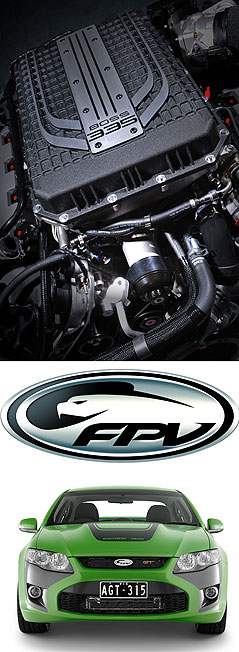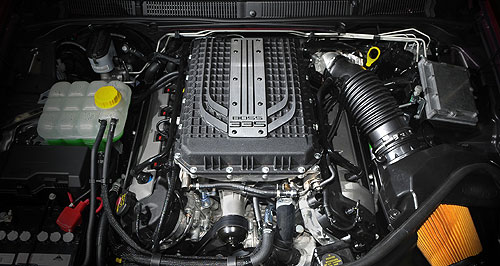Future models - FPV - GTFPV turns up the Miami heatStill the Boss: FPV will retain its Boss nameplate for its all-new, locally developed supercharged 5.0-litre V8. True-blue supercharged 5.0-litre V8 to set new 335kW benchmark for FPV in GT2 Sep 2010 FORD Performance Vehicles this week unveiled its $40 million home-grown supercharged 335kW/570Nm version of Ford’s new 5.0-litre Coyote V8 to power its latest Falcon-based GT from October, hinting that the heavily modified engine it calls ‘Miami’ has still more power up its sleeve. But don’t expect a return of the fabled Ford GT-HO nameplate any time soon, with FPV executives all but ruling out such a latter-day super sedan, saying the potent new FPV GT – the most powerful current Australian-built mass-produced car – will be the modern equivalent anyway. The locally developed blown engine, which is assembled in Victoria with up to 40 per cent local parts, is not only 20kW more powerful than the larger and heavier 315kW 5.4-litre Boss V8 it replaces, but cleaner and marginally more fuel efficient, at 13.6 litres per 100km in manual GT form (down from 14.2L/100km). The new all-alloy 32-valve double-overhead-cam V8 is also set to leapfrog rival Holden Special Vehicles’ naturally aspirated, pushrod 6.2-litre LS3 V8 in the performance stakes, eclipsing the power and torque of the 325kW Chevrolet-sourced engine in the HSV hero GTS by 10kW and 20Nm respectively. HSV is set to counter with its updated E3 range based on Holden’s Series II Commodore later this month, but modifications are unlikely to include a power boost to regain the bragging rights – yet. As GoAuto has reported, General Motors is spending up big on a new Gen V small-block V8 in the United States, and that engine, when it arrives in the next couple of years, almost certainly will raise the stakes again. For its part, FPV majority shareholder Prodrive Automotive Technology Asia Pacific clearly is anticipating a need to ramp up the engine’s performance at some point, with managing director Bryan Mears saying at this week’s launch of the new engine that the development project factored in “futuring” for the V8, adding: “I think we would be silly to limit ourselves.”  In the US, an after-market supercharging kit for the Ford Mustang’s Coyote V8 is said to produce a claimed 465kW, using the same Australian-made Harrop blower. In the US, an after-market supercharging kit for the Ford Mustang’s Coyote V8 is said to produce a claimed 465kW, using the same Australian-made Harrop blower.This time, FPV is building the Miami V8 in two states of tune for its sedan and ute range – a 315kW/545Nm version to power its entry level GS, and the range-topping 335kW/570Nm GT-spec, that will continue to be marketed under GT, GTP and GTE guises. Both engine variants hit peak power at 5750rpm, with the GS getting peak torque at 2000rpm and the GT version a little higher at 2200rpm. In the latter, the meaty torque flat-lines all the way to 6000rpm, while the GS engine drops away at 5500rpm. According to FPV engineers, the only difference between the two engines is the electronic calibration. FPV chief engineer Bernie Quinn said that low-to-mid-range torque was the key achievement of the supercharged engine, giving the new GT class-leading 80-120km/h overtaking punch and strong every-day performance. “Maybe once every six months you might get to peak power at 6000rpm, but every day you get into the car, you feel the torque,” he said. But Mr Quinn declined to quote acceleration times, saying the traditional 0-100km/h sprint time was meaningless due to a number of variables, including track surface conditions. Both engines will be offered with a revised six-speed ZF automatic transmission or revamped Tremac six-speed manual transmission with a new ZF twin-plate clutch from the Mustang GT500. Exact pricing will stay under wraps until the car’s media launch in the lead up to the Bathurst V8 Supercar race in October, but FPV says the prices will be held close to the out-going range prices, with the GS around $55,000 and the GT hero car starting at “just on $70,000”. These prices are set to undercut HSV’s current sedan range, which starts at $61,900 for the ClubSport GXP, rising to $83,900 for the GTS. Unlike its cross-town rival, FPV has no plans to introduce alternative fuel variants of its new V8, saying it will be petrol only. FPV says it started its search for a new V8 five years ago when it became apparent that the 5.4-litre Ford-sourced V8 would be too expensive to modify to achieve mandatory Euro 4 emissions regulations that came into force on July 1 this year. It looked at engines such as Jaguar’s V8 and larger Ford engines in the US. In the end, FPV opted for Ford’s then secret American-developed 5.0-litre Coyote V8, but as its performance was not much better than FPV’s outgoing, bigger-capacity 5.4-litre Boss V8, the Australian company bit the bullet on its own development program, which it started three years ago. Engineers looked at both turbocharging and supercharging as a way of beefing up outputs, but decided on supercharging because it not only offered better low-down response but also delivered a more compact engine package required for the engine to be fitted to the Falcon’s engine bay on Ford’s Broadmeadows production line. Mr Quinn said turbocharging might have delivered some energy savings in terms of parasitic losses, but these were cancelled out by the supercharged engine’s exhaust efficiency. In re-developing the engine, FPV basically ripped the original Coyote V8 apart, fitting new high-performance pistons, conrods, exhaust valves and crank balancer at the heart of the engine to cope with stresses of the supercharged performance. The supercharger was sourced locally from racer-turned-engineer Ron Harrop’s Harrop Engineering in Melbourne, who not only supplies HSV sister company Walkinshaw Performance with aftermarket blowers but also Ford Racing in the US. The blower was engineered to fit snugly in the ‘V’ at the top of the engine – again for packaging reasons – and equipped with the latest low-drag, high-efficiency Eaton TVS rotors that also provide forced induction to cars such as the Jaguar XKR. This system required new locally designed and built inlet manifold, along with Aussie cast stainless steel exhaust headers leading to the latest high-tech metal-matrix catalyst and an active exhaust system. The driver can manually open the exhaust valve “so the driver always knows what he is driving”. An open conical filter air intake – described by an FPV insider as an “engineer’s wet dream” – helps to feed the supercharger. While the supercharger adds 13kg to the engine’s weight, the alloy V8 is still 47kg lighter than the outgoing engine, meaning the new GT is set to weigh in only 10 or 15kg heavier than FPV’s six-cylinder turbocharged F6 cars, at about 1820kg (HSV’s GTS is 1829kg). Because so much of the engine was highly modified, the decision was taken to hand-assemble the V8 in Australia, using a kit of parts from the US Coyote V8, such as the cylinder block, heads and valvetrain, some high-performance parts imported from the US (such as the new exhaust valves and pistons), and source others such as the manifolds and supercharger assembly locally. FPV says the local engine assembly plant is already working six days a week building engines in readiness for the October launch of the new GT range, which will continue to carry ‘Boss’ badges for tradition’s sake. It says its first batch of 252 units was snapped up by dealers within 48 hours, with 40 of those destined for New Zealand. FPV says it will take years to recoup its $40 million investment in the engine and engineering it to the Falcon body, but that cost might be defrayed with exports, should Ford Motor Company decide to pick it up for a North American product (see separate story). FPV said the forthcoming upgrade to the FPV range will include refinements to the six-cylinder F6 turbo models to comply with Euro 4 emissions requirements.  Read more2nd of September 2010  FPV eyes North America for V8 exportsAussie 335kW supercharged Ford V8 engine might boomerang back to DetroitAll future models Alfa Romeo Alfa Romeo Abarth Abarth Audi Audi Aston Martin Aston Martin BMW BMW Bentley Bentley Chrysler Chrysler Chevrolet Chevrolet Dodge Dodge Citroen Citroen Ferrari Ferrari DS DS Ford Ford Fiat Fiat FPV FPV Foton Foton Haval Haval Great Wall Great Wall Honda Honda Holden Holden Hyundai Hyundai HSV HSV Isuzu Isuzu Infiniti Infiniti Jeep Jeep Jaguar Jaguar Lamborghini Lamborghini Kia Kia Lexus Lexus Land Rover Land Rover Mazda Mazda Maserati Maserati Mercedes-Benz Mercedes-Benz McLaren McLaren Mini Mini Nissan Nissan Mitsubishi Mitsubishi Peugeot Peugeot Opel Opel Proton Proton Porsche Porsche Renault Renault Ram Ram Saab Saab Rolls-Royce Rolls-Royce Smart Smart Skoda Skoda Subaru Subaru SsangYong SsangYong Tesla Tesla Suzuki Suzuki Toyota Toyota Volvo VolvoMotor industry news |
Click to shareFPV modelsAll future models Alfa Romeo Alfa Romeo Abarth Abarth Audi Audi Aston Martin Aston Martin BMW BMW Bentley Bentley Chrysler Chrysler Chevrolet Chevrolet Dodge Dodge Citroen Citroen Ferrari Ferrari DS DS Ford Ford Fiat Fiat FPV FPV Foton Foton Haval Haval Great Wall Great Wall Honda Honda Holden Holden Hyundai Hyundai HSV HSV Isuzu Isuzu Infiniti Infiniti Jeep Jeep Jaguar Jaguar Lamborghini Lamborghini Kia Kia Lexus Lexus Land Rover Land Rover Mazda Mazda Maserati Maserati Mercedes-Benz Mercedes-Benz McLaren McLaren Mini Mini Nissan Nissan Mitsubishi Mitsubishi Peugeot Peugeot Opel Opel Proton Proton Porsche Porsche Renault Renault Ram Ram Saab Saab Rolls-Royce Rolls-Royce Smart Smart Skoda Skoda Subaru Subaru SsangYong SsangYong Tesla Tesla Suzuki Suzuki Toyota Toyota Volvo VolvoMotor industry news |
















Facebook Twitter Instagram